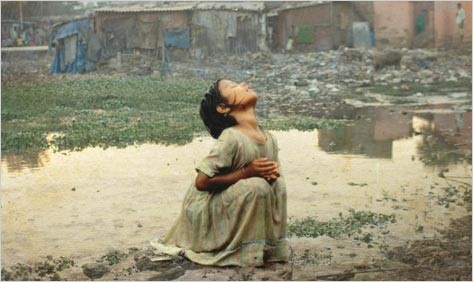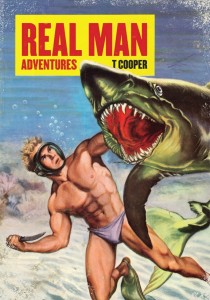BOOKS: The Year In Books, 2012
The Year of the Velvet Hot Mama, or Darwin’s Reality in the Age of Supernormal Stimuli ■ by R.E. Paris
I thought perhaps Fifty Shades of Grey should be the book topic of the year. Not because of the way it is written, but because any book that can get millions of women to masturbate in waves and no doubt sometimes in time-zone unison, across this mighty, mighty nation, is part of the spirit of a new age.
In response, HarperCollins announced that it is set to republish Nine and a Half Weeks, though the actual release date has not yet been screamed at the top of the publisher’s lungs, nor muttered in guttural tones.
More importantly, the personal as political in 2012 marked a year of velvet revolution. Reality outwitted the spin and masturbatory fantasies, even if it didn’t outsell them. Looking at the year in books, I wondered who was wrong and who was right about the current events and future prospects. Here are some authors worth reading.
John B. Judis and Ruy Texeira outlined the current world more than a decade ago in The Emerging Democratic Majority (Scribner, 2002). Yours truly was talking up that book back then. Judis and Texeira were the Nate Silvers of the long-term.
◗ Silver is the author of The Signal and the Noise: Why So Many Predictions Fail—But Some Don’t (Penguin, 2012). The book is a manifesto for reality-based thinking. Silver correctly predicted the 2008 and 2012 presidential elections with stunning accuracy. Silver has gone on to recommend that conservatives return to their roots and back marijuana legalization.
Nate Silver: A Manifesto For Reality-Based Thinking
■
◗ Smoke Signals: A Social History of Marijuana (Scribner, 2012), by Martin Lee. The cannabis re-legalization votes in Washington State and Colorado were historic political events, ceasefires in the war on drugs. No one expects Indiana to be a leader in this ground shift even though the social conservative demographic has repeatedly been on the wrong side of history since the 1960s.
◗ All In The Family (Hill and Wang, 2012), by Robert Self, discusses the Reagan re-alignment that began in the 1960s as a reaction to race, gender and sexuality politics. Self walks the reader through the landscape of the American culture wars. That landscape now includes the impact of science denial.
◗ Ice: Portraits of Vanishing Glaciers by James Balog with a forward by Terry Tempest Williams (Rizzoli, 2012). Balog’s work has been exhibited in museums and published in National Geographic, The New Yorker, and Vanity Fair. His work was also featured on the PBS documentary, “Extreme Ice.”
Two hundred color photographs compiled from Balog and his Extreme Ice Survey (EIS) team chronicle changing glaciers since 2005 in France, Switzerland, Iceland, Greenland, Nepal, Bolivia, Antarctica and the United States.
◗ Behind the Beautiful Forevers: Life, Death, and Hope in a Mumbai Undercity (Random House, 2012). by Katherine Boo, is a stunning look at the reality of economic disparity through the lives of more than 300 people.
Katherine Boo’s Stunning Look At Economic Disparity In Mumbai
■
◗ Memoir of a Debulked Woman, (Norton, 2012) is by Susan Gubar, a feminist scholar from IU. The Madwoman in the Attic, which she co-authored, was nominated for the Pulitzer Prize. Her memoir unravels the ribbons of a cancer story to talk about one women’s view of her changing world read through the body.
◗ Real Man Adventures (McSweeney’s, 2012) by T Cooper is a memoir centering on gender and identity by a female-to-male transitioned citizen. Cooper’s exploration of gender and culture is part of a move beyond binary thinking. The book raises interesting questions about stereotypes, the author’s as well as our own.
T Cooper’s Exploration Of Gender And Culture Moves Beyond Binary Thinking
■
◗ The Grey Album: On the Blackness of Blackness, by Kevin Young (Graywolf Press, 2012). Young formerly taught poetry in the writing program at IU; this is his first book of prose. These essays parse Young’s experience as a person of color within the context of American cultural life through the work of artists in various genres.
◗ Kurt Vonnegut: Letters (Delacorte, 2012), edited by Indiana author and Vonnegut friend Dan Wakefield (Going All The Way), is the first collection of Vonnegut letters. The Lilly Library’s holdings were pivotal for this first compilation. Wakefield’s commentary provides background information for the collection.
Michael Martone is the Indiana author who has taken on the mantle, or hair shirt, of the Twain/Vonnegut humorist in postmodern garb. Read his work. He is also one of the editors of the new Indiana University Break Away series of paperback originals.
◗ An American Tune (Indiana University Press, 2012), by Barbara Shoup, is one of the latest titles in the Breakaway Series. The story takes place in Bloomington as a woman confronts her radical past and suddenly complicated present. Shoup is an author of seven novels and is also the Executive Director of the Writers’ Center of Indiana
More 2012 Fiction to read:
◗ Blasphemy: New and Selected Stories (Grove Press, 2012) by Sherman Alexie
◗ Telegraph Avenue (Harper, 2012) by Michael Chabon
◗ The Round House, (Harper, 2012) by Louise Erdrich
◗ The Real and the Unreal: Selected Stories Volume One: Where on Earth (Small Beer Press, 2012) by Ursula Le Guin
◗ This Is How You Lose Her, (Riverhead, 2012) by Juno Diaz
◗ Building Stories (Pantheon, 2012), by Chris Ware, is a book that is designed to be experienced as a physical object. Ware’s book house shares stories of individuals who are as separated from one another as the physical contexts that hold their stories.
The book is a big box with 14 items, including books, pamphlets, and a comics section. The book-as-object aesthetic is one McSweeney’s has consistently maintained. Ware has worked with McSweeney’s in the past, most notably with the McSweeney’s 13 Comics Issue and the McSweeney’s 33 newspaper facsimile edition.
◗ “Maker culture” in tech and beyond is part of this 2012 revolution, beyond the bindings of books. Makers: The New Industrial Revolution (Crown, 2012), by Chris Anderson, will start you on your journey.
Why Does the World Exist? An Existential Detective Story (Liveright, 2012), by Jim Holt, provides a maker underpinning by examinng something and nothing while questioning the assumption that “nothing” is the “default” of existence.
You are here.
■
The Ryder, January 2013



